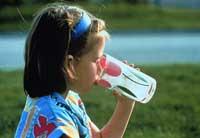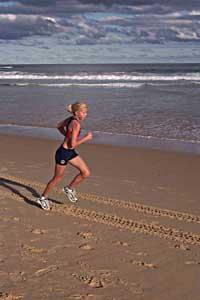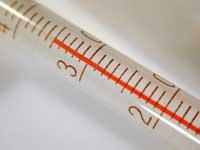Heat yes, but to the extent
When the sun starts to sound strong, we feel the need to leave home. We do more exercise and put in the sun much of our skin. It is hot and our body is also heated. This is when body cooling systems are launched to prevent the body from getting too hot.

Homeoteric animals are those who keep blood at stable temperature throughout the year, including humans. In our case the optimal internal temperature is between 36º and 37.5º C. Our body keeps this temperature active through different mechanisms.
When the outside temperature is cooler than the internal temperature, the body produces heat. But when the outside begins to heat, our interior also begins to warm. If the internal temperature exceeds 37.5 ° C, it is very dangerous for metabolism, since from a temperature worsens the functioning of enzymes that are a fundamental part of our metabolism. In short, enzymes are proteins and proteins tend to denaturate at high temperatures. Denaturalization means that molecules lose their three-dimensional structure. As a result, they completely lose their reaction capacity with other molecules, causing a high risk of breakdown of metabolism.
Sweat, body soda

To prevent the internal temperature of the body from rising too much, a part of the brain, the hypothalamus, starts cooling systems. Blood vessels, capillaries, near the skin expand and carry more blood. This change accentuates the work of the heart and accelerates the heartbeat. In addition, the sweat glands we have in the skin have more work in the production of sweat.
When more blood is transported in capillaries near the skin, the heat passes from the blood to the surface. On the surface, this heat form energy is used to evaporate sweat. Therefore, this heat from the inside is consumed and refreshes the body. However, for evaporation it is necessary that there is a minimum stream of air near the skin. If no air passes, sweat cannot evaporate and remains in it. Therefore, heat will not be released.

Sweat is the most effective mechanism to refresh our body, because it uses a lot of heat to evaporate sweat. Therefore, it is much more refreshing to use a fan for the body than to drink a cold drink. But for sweat to perform its function, it is very important to wear proper clothing. As much nasal as possible will be used to pass air near the skin and evaporate sweat. Clothes that stick to the body absorb sweat, but do not let evaporate, so instead of cooling heat us more.
The more heat you do, the more work your body has to do to keep you cool: the more blood will pass near your skin and the more sweating your body will do. It is estimated that at an ambient temperature of 37ºC, an hour in the sun, a person loses a liter of water through sweat. Exercise can result in a loss of two and a half liters per hour. It is important to take good care of this water loss, since it is essential to maintain an adequate level of body hydration. In addition to water, abundant mineral salts and electrolytes are lost through sweat. On days of great loss, it is very important to eat foods rich in these molecules, fruits and vegetables.
Adverse effects of heat

The best way to refresh sweating doesn't mean the system is perfect. When the blood that moves near the skin rises, the blood reaches much less the internal muscles and organs. This can cause headache and fatigue in some cases. In addition, the amount of water lost by sweat makes the blood much stronger and the heart has more difficulty moving around the body. If the brain does not have enough blood, dizziness can occur and, due to lack of mineral salts, cause muscle cramps. Moreover, when body cooling problems appear or if they remain in a very hot place for a long time, there is a risk of suffering a heat stroke.
The heat stroke produces a total block of the body's cooling systems. This person cannot sweat enough to refresh the body and also tighten the capillaries close to the skin. In addition, it accelerates the heart and respiratory rate. As a result, heat cannot be expelled and the risk of overheating increases considerably. If the body temperature reaches 40º C, the brain can be affected and there is a very high risk of suffering a heart attack. Therefore, the person with heat stroke should be transferred to the hospital as quickly as possible.

Older people and young children perceive the effects of heat the most. The physiological responses of older people to heat are less positive and are more at risk for heart attacks or heart problems during days of intense heat. Young children, on the other hand, have underdeveloped heat control systems and are also easier to dehydrate than adults.
To avoid all these problems, the measures to take in the hottest days of summer are very simple:
- Wear loose, light-colored clothing.
- Drink plenty of water and don't forget mineral salts.
- Do not drink alcoholic or caffeinated beverages, as they are diuretic and increase dehydration.
- Avoid foods rich in protein or fat, replacing them with light meals.
- Don't play sports at temperatures above 37ºC and take the day with peace of mind.
- Whenever possible walk in the shade.
Published in 7K.
Buletina
Bidali zure helbide elektronikoa eta jaso asteroko buletina zure sarrera-ontzian











